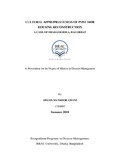Cultural appropriateness of post Sidr housing reconstruction : a case of Sharankhola, Bagerhat

View/
Date
2018Publisher
BRAC UniversityAuthor
Ghani, Shams MansoorMetadata
Show full item recordAbstract
Bangladesh is one of the most disaster prone countries in the world. Among the natural hazards cyclones and the associated storm surges are considered as the major threat to our 710km coastal belt with around 28 million people living within the risk zone. One of the major impacts of cyclone and storm surge is on human habitat severely disrupting the livelihood of the affected population. The usual response from the Government and different humanitarian organizations is providing emergency temporary shelter assistance and eventually a transitional or core shelter assistance following a ‘built back better’ approach focusing on resilience building and risk reduction. Cyclone Sidr, which hit our coast line in late 2007, caused massive destruction of settlements and was followed by an unprecedented reconstruction initiative by the government and NGOs changing the rural landscape permanently within a few years. Most of the agencies provided a cyclone resistant core shelter with potential for future addition and alteration by the owners. Such a multi-agency intervention, without proper consideration of rural culture of responsive built environment and indigenous materials and technologies may lead to a culturally inappropriate settlement degrading our rural landscape and heritage. This research aims to analyze cultural elements of our coastal settlement in general and evaluate the post Sidr assisted reconstruction works in the backdrop of cultural appropriateness. Sharankhola, one of the most intervened areas after Sidr, is selected as the study area of this research. The later alterations and modifications by the users will be studied as an indication of cultural inadequacies. Observation, focus group discussions and household survey in the study area will be conducted to ascertain user feedback and consciousness about culture and the outcome of the assisted shelters.
